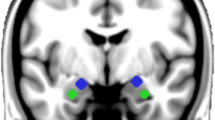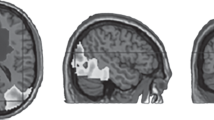Abstract
The aim was to study the effect of adaptive (cognitive reappraisal) and non-adaptive (expressive suppression, suppression, and rumination) styles of emotion regulation on the balance of connectivity of resting state networks. Fifty-one healthy volunteers (29 women) aged from 18 to 51 years gave their permission to recordings their EEGs at rest and filled in the Emotional Regulation Questionnaire (Gross), White Bear Suppression Inventory and Ruminative Responses Scale. The connectivity measures of resting state networks were evaluated based on EEG data. Networks were identified using the “seed” method. The effects of different styles of emotional regulation on the balance of connectivity of networks were analyzed by regression method. Non-adaptive styles of emotional regulation (suppression and rumination) correlated with the dominance of the default mode network in the right temporal cortex, that could reflect the processes of emotional introspection. The adaptive strategy cognitive reappraisal of emotions correlated with the dominance of task-positive networks in the left dorsolateral prefrontal cortex, such result may be associated with more effective control of negative thoughts and a higher level of positive emotions.


Similar content being viewed by others
REFERENCES
Aldao, A., Nolen-Hoeksema, S., and Schweizer, S., Emotion-regulation strategies across psychopathology: a meta-analytic review, Clin. Psychol. Rev., 2010, vol. 30, no. 2, p. 217.
Gross, J.J., Emotion regulation: affective, cognitive, and social consequences, Psychophysiology, 2002, vol. 39, no. 3, p. 281.
Gross, J.J., The emerging field of emotion regulation: an integrative review, Rev. Gen. Psychol., 1998, vol. 2, no. 3, p. 271.
Ray, R.D., McRae, K., Ochsner, K.N., and Gross, J.J., Cognitive reappraisal of negative affect: converging evidence from EMG and self-report, Emotion, 2010, vol. 10, no. 4, p. 587.
Shiota, M.N. and Levenson, R.W., Turn down the volume or change the channel? Emotional effects of detached versus positive reappraisal, Pers. Soc. Psychol., 2012, vol. 103, no. 3, p. 416.
Boehme, S., Biehl, S.C., and Muhlberger, A., Effects of differential strategies of emotion regulation, Brain Sci., 2019, vol. 9, no. 9, p. 225.
Gross, J.J. and John, O.P., Individual differences in two emotion regulation processes: Implications for affect, relationships, and well-being, J. Pers. Soc. Psychol., 2003, vol. 85, no. 2, p. 348.
Pankratova, A.A. and Kornienko, D.S., A Russian adaptation of the Emotional Regulation Questionnaire (J. Gross), Vopr. Psikhol., 2017, vol. 5, p. 139.
Nolen-Hoeksema, S., Wisco, B.E., and Lyubomirsky, S., Rethinking rumination, Perspect. Psychol. Sci., 2008, vol. 3, no. 5, p. 400.
Hamilton, J.P., Furman, D.J., Chang, C., et al., Default-mode and task-positive network activity in major depressive disorder: implications for adaptive and maladaptive rumination, Biol. Psychiatry, 2011, vol. 70, no. 4, p. 327.
Olatunji, B.O., Naragon-Gainey, K., and Wolitzky-Taylor, K.B., Specificity of rumination in anxiety and depression: a multimodal meta-analysis, Clin. Psychol.: Sci. Pract., 2013, vol. 20, no. 3, p. 225.
Nolen-Hoeksema, S., Ruminative coping with depression, in Motivation and Self-Regulation across the Life Span, Heckhausen, J. and Dweck, C.S., Eds., Cambridge: Cambridge Univ. Press, 1998.
Aldao, A. and Nolen-Hoeksema, S., Specificity of cognitive emotion regulation strategies: a transdiagnostic examination, Behav. Res. Ther., 2010, vol. 48, no. 10, p. 974.
Rassin, E., The White Bear Suppression Inventory (WBSI) focuses on failing suppression attempts, Eur. J. Pers., 2003, vol. 17, no. 4, p. 285.
Wegner, D.M. and Zanakos, S., Chronic thought suppression, J. Pers., 1994, vol. 62, no. 4, p. 615.
Bressler, S.L. and Menon, V., Large-scale brain networks in cognition: emerging methods and principles, Trends Cognit. Sci., 2010, vol. 14, no. 6, p. 277.
Raichle, M.E., MacLeod, A.M., Snyder, A.Z., et al., A default mode of brain function, Proc. Natl. Acad. Sci. U.S.A., 2001, vol. 98, no. 2, p. 676.
Buckner, R.L., Andrews-Hanna, J.R., and Schacter, D.L., The brain’s default network: anatomy, function, and relevance to disease, Ann. N.Y. Acad. Sci., 2008, vol. 1124, p. 1.
Mason, M.F., Norton, M.I., van Horn, J.D., et al., Wandering minds: the default network and stimulus-independent thought, Science, 2007, vol. 315, no. 5810, p. 393.
Raichle, M.E., The brain’s default mode network, Annu. Rev. Neurosci., 2015, vol. 38, p. 433.
Rilling, J.K., King-Casas, B., and Sanfey, A.G., The neurobiology of social decision-making, Curr. Opin. Neurobiol., 2008, vol. 18, no. 2, p. 159.
Harrison, B.J., Pujol, J., Ortiz, H., et al., Modulation of brain resting-state networks by sad mood induction, PLoS One, 2008, vol. 3, no. 3, p. 1.
Dailey, N.S., Smith, R., Raikes, A., et al., Reduced functional connectivity in the executive control network following mild traumatic brain injury: implications for emotional regulation, Biol. Psychiatry, 2018, vol. 83, no. 9, p. 162.
Pan, J., Zhan, L., Hu, C., et al., Emotion regulation and complex brain networks: association between expressive suppression and efficiency in the fronto-parietal network and default-mode network, Front. Hum. Neurosci., 2018, vol. 12, p. 70.
Smitha, K.A., Akhil Raja, K., Arun, K.M., et al., Resting state fMRI: a review on methods in resting state connectivity analysis and resting state networks, Neuroradiol. J., 2017, vol. 30, no. 4, p. 305.
Erk, S., Mikschl, A., Stier, S., et al., Acute and sustained effects of cognitive emotion regulation in major depression, J. Neurosci., 2010, vol. 30, no. 47, p. 15726.
Johnstone, T., van Reekum, C.M., Urry, H.L., et al., Failure to regulate: counterproductive recruitment of top-down prefrontal-subcortical circuitry in major depression, J. Neurosci., 2007, vol. 27, no. 33, p. 8877.
Sheline, Y.I., Barch, D.M., Price, J.L., et al., The default mode network and self-referential processes in depression, Proc. Natl. Acad. Sci. U.S.A., 2009, vol. 106, no. 6, p. 1942.
Johnson, M.K., Nolen-Hoeksema, S., Mitchell, K.J., and Levin, Y., Medial cortex activity, self-reflection and depression, Soc. Cognit. Affective Neurosci., 2009, vol. 4, no. 4, p. 313.
Treynor, W., Gonzalez, R., and Nolen-Hoeksema, S., Rumination reconsidered: a psychometric analysis, Cognit. Ther. Res., 2003, vol. 27, no. 3, p. 247.
Bocharov, A.V., Knyazev, G.G., Savostyanov, A.N., et al., Relationship of depression, anxiety and rumination scores with EEG connectivity of resting state networks, Hum. Physiol., 2021, vol. 47, no. 2, p. 123.
Knyazev G.G., Savostyanov A.N., Bocharov, A.V., et al., Task-positive and task-negative networks and their relation to depression: EEG beamformer analysis, Behav. Brain Res., 2016, vol. 306, p. 160.
Knyazev, G.G., Savostyanov, A.N., Bocharov, A.V., et al., Task-positive and task-negative networks in major depressive disorder: a combined fMRI and EEG study, J. Affective Disord., 2018, vol. 235, p. 211.
Brookes, M.J., Liddle, E.B., Hale, J.R., et al., Task induced modulation of neural oscillations in electrophysiological brain networks, NeuroImage, 2012, vol. 63, no. 4, p. 1918.
Brookes, M.J., Woolric, M., Luckhoo, H., et al., Investigating the electrophysiological basis of resting state networks using magnetoencephalography, Proc. Natl. Acad. Sci. U.S.A., 2011, vol. 108, no. 40, p. 16783.
Seeley, W.W., Menon, V., Schatzberg, A.F., et al., Dissociable intrinsic connectivity networks for salience processing and executive control, J. Neurosci., 2007, vol. 27, no. 9, p. 2349.
Nezlek, J.B. and Kuppens, P., Regulating positive and negative emotions in daily life, J. Pers., 2008, vol. 76, no. 3, p. 561.
Hofmann, S.G., Heering, S., Sawyer, A.T., and Asnaani, A., How to handle anxiety: the effects of reappraisal, acceptance, and suppression strategies on anxious arousal, Behav. Res. Ther., 2009, vol. 47, no. 5, p. 389.
Kaiser, R.H., Andrews-Hanna, J.R., Wager, T.D., and Pizzagalli, D.A., Large-scale network dysfunction in major depressive disorder: a meta-analysis of resting-state functional connectivity, JAMA Psychiatry, 2015, vol. 72, no. 6, p. 603.
Rive, M.M., van Rooijen, G., Veltman, D.J., et al., Neural correlates of dysfunctional emotion regulation in major depressive disorder. A systematic review of neuroimaging studies, Neurosci. Biobehav. Rev., 2013, vol. 37, no. 10, p. 2529.
Zilverstand, A., Parvaz, M.A., and Goldstein, R.Z., Neuroimaging cognitive reappraisal in clinical populations to define neural targets for enhancing emotion regulation. A systematic review, NeuroImage, 2017, vol. 151, p. 105.
Iznak, E.V., Iznak, A.F., and Oleichik, I.V., Quantitative EEG in prediction of efficiency of combined antidepressive treatment using transcranial magnetic stimulation, Hum. Physiol., 2020, vol. 46, no. 6, p. 621.
Pathak, Y., Salami, O., Baillet, S., et al., Longitudinal changes in depressive circuitry in response to neuromodulation therapy, Front. Neural Circuits, 2016, vol. 10, p. 1.
Silvers, J.A., Shu, J., Hubbard, A.D., et al., Concurrent and lasting effects of emotion regulation on amygdala response in adolescence and young adulthood, Dev. Sci., 2016, vol. 18, no. 5, p. 771.
Winecoff, A., LaBar, K.S., Madden, D.J., et al., Cognitive and neural contributors to emotion regulation in aging, Soc. Cognit. Affective Neurosci., 2011, vol. 6, no. 2, p. 165.
Badre, D. and Wagner, A.D., Left ventrolateral prefrontal cortex and the cognitive control of memory, Neuropsychologia, 2007, vol. 45, no. 13, p. 2883.
Demaree, H.A., Everhart, D.E., Youngstrom, E.A., and Harrison, D.W., Brain lateralization of emotional processing: historical roots and a future incorporating “dominance,” Behav. Cognit. Neurosci. Rev., 2005, vol. 4, no. 1, p. 3.
ACKNOWLEDGMENTS
The authors express their gratitude to N.V. Dmitrienko for helping gather research data.
Funding
The work was supported by RFBR (project no. 20-013-00404, research conduct; project no. 18-29-13027, article preparation) and federal budget for fundamental research (theme no. АААА-А21-121011990039-2, data analysis method development).
Author information
Authors and Affiliations
Corresponding author
Ethics declarations
COMPLIANCE WITH ETHICAL STANDARDS
All studies were conducted in compliance with the principles of biomedical ethics formulated in the Declaration of Helsinki (1964) and its later updates and approved by local bioethical committee of Scientific Research Institute of Neurosciences and Medicine (Novosibirsk).
CONFLICT OF INTEREST
The authors declare no direct or potential conflicts of interest.
INFORMED CONSENT
Each participant gave his voluntary written consent after being explained potential risks and advantages, along with the nature of the forthcoming study.
Additional information
Translated by A. Deryabina
Rights and permissions
About this article
Cite this article
Bocharov, A.V., Savostyanov, A.N., Tamozhnikov, S.S. et al. The Association between Emotion Regulation Strategy and Oscillation Balance of Resting State Networks. Hum Physiol 48, 30–36 (2022). https://doi.org/10.1134/S0362119722010030
Received:
Revised:
Accepted:
Published:
Issue Date:
DOI: https://doi.org/10.1134/S0362119722010030




